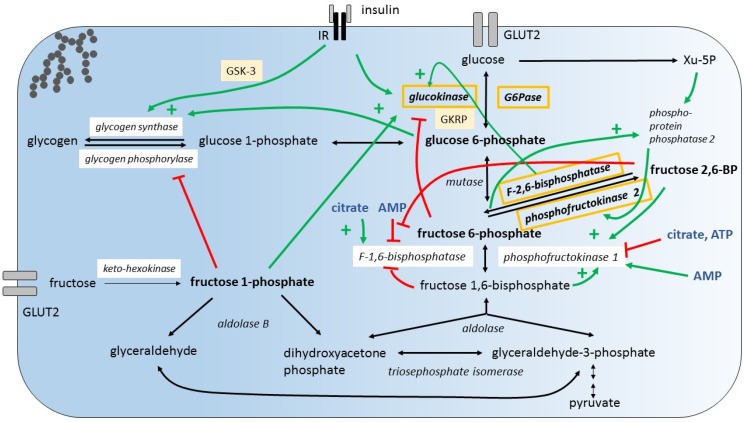Figure 2.
Hepatic hexose uptake and regulatory mechanisms that control hexose breakdown. Glucose and fructose is taken up by glucose transporter 2 (GLUT2). Fructose metabolites regulate key enzymes of glucose metabolism. (A) Fructose stimulates glucose uptake by distinct mechanisms:(1) Fructose 1-phosphate (F1P) antagonizes the inhibition of glucokinase (GK) by glucokinase regulatory protein (GKRP) promoting glucose 6-phosphate (G6P) production; (2) newly synthesized G6P stimulates glycogen synthase; (3) F1P inhibits glycogen phosphorylase. (B) Fructose 6-phosphate (F6P) and xylulose 5-phosphate (Xu-5P) activate phosphoprotein-phosphatase 2 which activates phosphofructokinase 2 promoting generation of fructose 2,6-bisphosphate (F2,6BP). F2,6BP activates phosphofructokinase 1 and inhibits F-1,6-bisphosphatase. (C) Insulin signaling increases glucokinase expression and promotes glycogen synthesis enhancing glycogen-synthase-kinase-3 (GSK-3) phosphorlyation. (D) From metabolic control analysis it is concluded that in the fed, hyperglycemic state, glucose exchange flux is controlled by GK, fructose-2,6-bisphosphatase, glucose 6-phosphatase (G6Pase) and phosphofructokinase-2 (orange box), while in the fasted, hypoglycemic state pyruvate carboxylase, and lactate transporter control the glucose exchange flux [49]. IR, insulin receptor; AMP, adenosine mono-phosphate; ATP, adenosine tri-phosphate. For completeness, the illustration contains also some additional regulatory mechanisms not discussed in the article.

